709-218-7927 The Landfall Garden House 60 Canon Bayley Road Bonavista, Newfoundland CANADA A0C 1B0 |
|---|
Soil Remediation
Saturday, May 22, 2021
I live alone on a small town lot in Bonavista, Newfoundland. I live simply.
Bonavista folks brag about three things: “How much wind we got”, “How much rain we got”, and “How little soil we got”. This project addresses the third of these claims. See Rain-water harvesting and 12vDC projects for material on the other topics.
This small bed, about twenty feet long and fifteen inches wide, took me almost three weeks to dig out, off and on. Large rocks and small stones to be pried out and hand-sieved through.
After a rainfall, the soil is washed down, off any pebbles or gravel, revealing a fresh overnight harvest of rock. Every time the rain falls.
Some of the foot-sized rocks pried from the bed, each time my shovel Clangs! As I push it through the sod.
And when I dig out a chunk of lawn to make a vegetable bed, there is always a neighbour who covets the sods.
A first primitive essay in a compost heap at the south end of my shed.
An improved idea, using modular panels cobbled together from old timber.
Sawdust and grass clippings are easy to get in Bonavista. Sawdust comes when people rake out the area where last fall they sawed logs for fuel; grass clippings come from young lads who mow lawns for cash.
Dumping a truck load of grass clippings at my place saves a 40 to 60 minute trip out to the tip, and that time can be spent mowing another lawn at $20.
Two modules are full. I am partway through emptying a third. I started these modules in June, and by August I was making use of the partially rotted material.
Two modules. I spent a few pleasant days in the shed with a panel saw sawing scrap timber into standard lengths, then driving 1 ½ “ wood screws in with a claw hammer.
Mid-September and a close look at a short-term compost block. Dried grass sits on top.
Mid-October and I am chewing my way through a two-column modular compost heap.
At this western end the blocks are oldest. In the background is the receiving area where grass clippings and sawdust are barrowed up from the driveway and mixed by piling alternate layers onto the heap.
The heap is emptied from the edge, and this effects more mixing as the material is tossed into an empty module.
We ripped the asphalt of the second driveway. I haven’t owned a car since 2003, so a second driveway is surely redundant. Under the bitumen was pebbly gravel.
I raked pebbles off the surface and used them on a neighbour’s swampy driveway. Now I am trying to split a large embedded rock with alternate bouts of fire and water.
A truck load of grass clippings dropped between the end of the driveway and the front of the shed. These will be barrowed to the receiving area at the rear of the shed.
Some loads of grass clippings bring a bonus. The housebricks make a small camp-fire barbecue pit for me. Another day there was enough rhubarb to make six large bottles of stewed pulp. The mower had been told to “tidy up the yard”.
My second summer here, my first batch of crop. The Zucchini effectively estranged me from visiting neighbours for a while. In the nearer bed, cabbage, beets, cherry tomatoes.
I use a 44-gallon drum for vegetable scraps. When snow blankets the yard I do not need to wade to the compost heap at the rear. Indeed, that large heap never receives kitchen scraps.
The drum is tipped over because I am going to barrow the digested scraps to the big pit. There will be no visible material there, just brown and black material.
The driveway with its first load. We were too late in the year for much grass, so the area over-wintered with nothing much to do.
I harbour huge worms come spring. April 19th.
A pile of rubble which was dug out with a back hoe to make a trench for a power cable. This material needs to be sieved and used to body-up a compost heap.
A friend dropped off an old two-seater stroller. I removed all the fittings and bolted a bread-tray where the seat used to be. This experimental version used a wooden leg to prop up the device, now discarded.
A collection of sieve-like gratings.
I tried using just the bread crate. Shovel rubble into the crate, most of the dry fine stuff falls into the barrow which can be wheeled away.
Shake the handle and we are left with a tray of pebbles which can be wheeled away …
… to a staging area where I plan to have four distinct piles of material in progress.
I make seed trays from scraps of Masonite and skirting board. Last year I made them from planking, but loaded with damp soil they were too heavy to cart indoors and out again when frost threatened.
Now I build three sieves from 1/8 “ plywood. I have one-inch, half-inch, and quarter-inch mesh. The sieves drop into and out of that bread crate.
Higher sides mean that the rocks do not bounce out and into the barrow or back on the ground.
That said I might trim the rear edge, the one closest to the handle to about half its current height so that I can see how well the sieve is emptying.
As well, I am using too much energy to bounce the sieve. I must disable the shock-absorbers on the frame. The things you learn …
Moments like these make my heart leap with joy. This worm was temporarily flooded out of its burrow. I took the photo and covered the worm with dried mats of grass and soil so that the worm could return underground after catching its breath. Check out the HUGE egg-saddle, soon to release new soil-makers into my gardens.
Sunday, May 15, 2022
I built my first pit to this design on Foxcote Avenue in the year 2000. Now I have a chance to do better, if only because I now have a large stock of scrap timber.
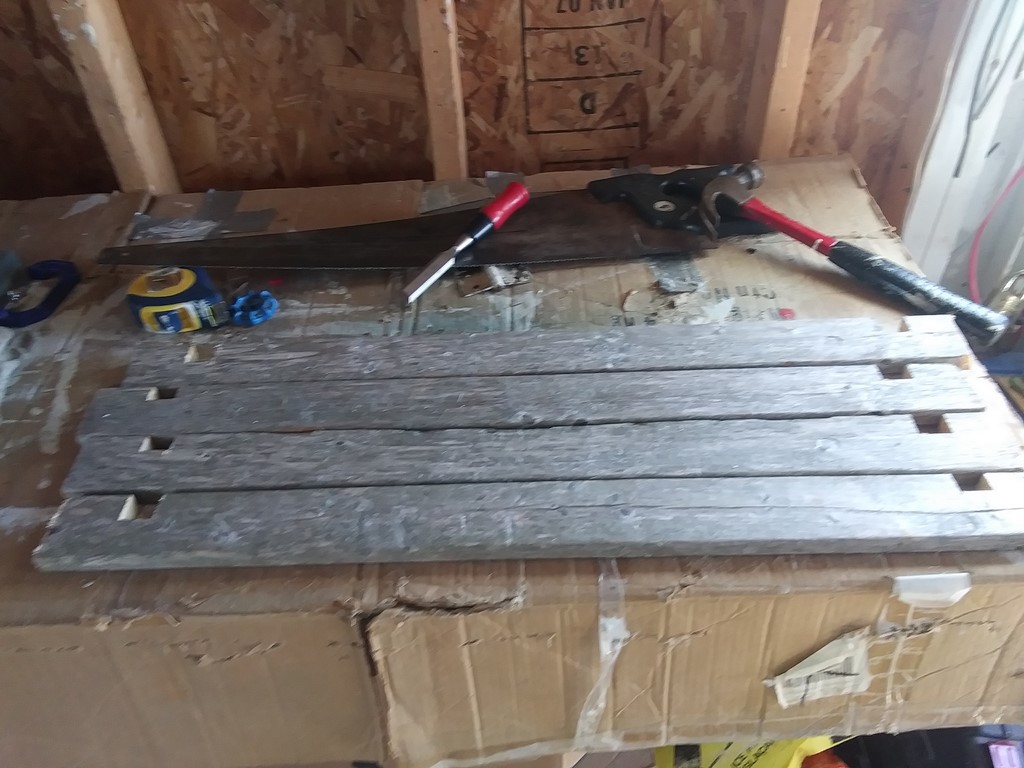
I take four palings, same length, and cut a one-inch notch at both ends of each paling. If you do this now with four strips of paper you will be able to follow along and see how it works.
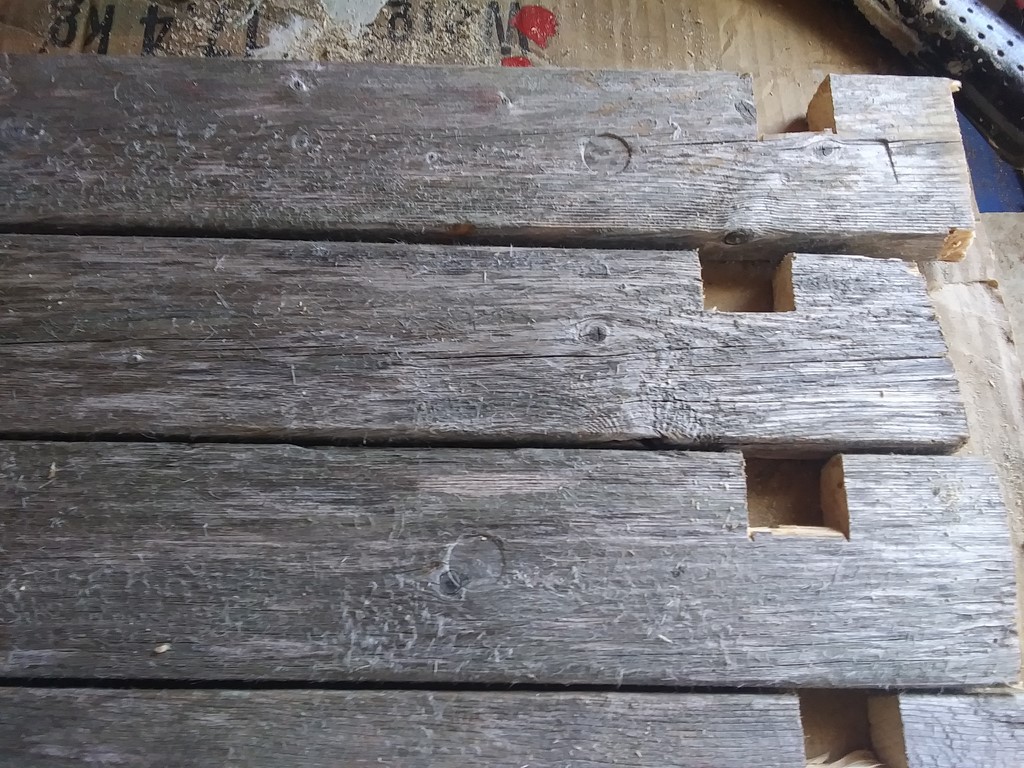
A closer view of the notches. These are only roughly worked; if you do not have a chisel, a large flat-blade screwdriver will work as well to punch out most of the wood.
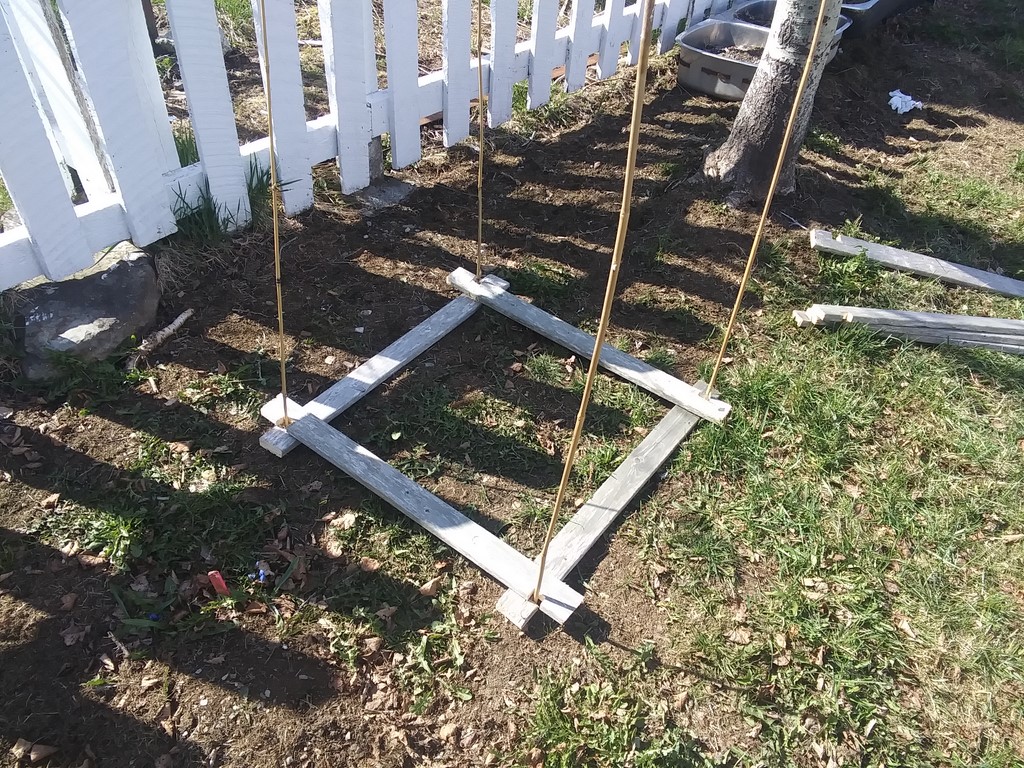
I have used four thin (one-quarter inch) bamboo stakes pushed at most two inches into the lawn by hand. Just enough to stop the ends shifting sideways.
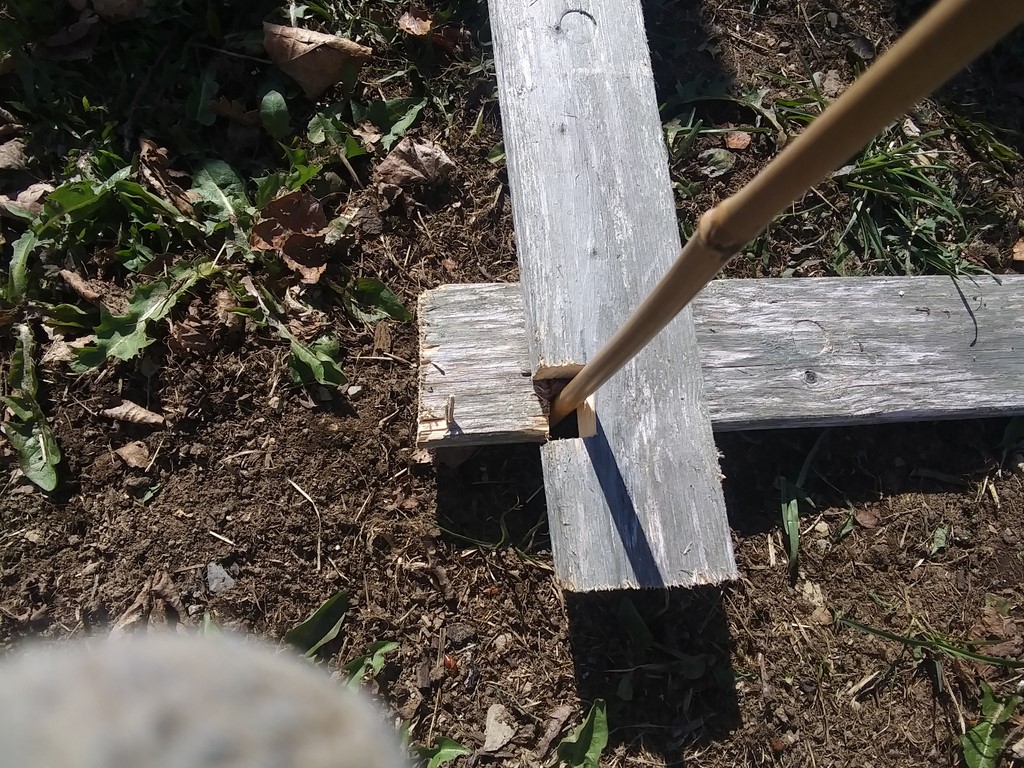
The lower paling (running N-S) has the notch facing towards me; the upper (E-W) has the notch facing to my left. On account of the lower paling, the bamboo cane cannot flex to the north, south, or to the west. On account of the upper paling, the bamboo cane cannot flex to the east, west, or to the south.
It follows that the cane can not shift to the north, east, south or west; that is, the cane is locked in place.
It follows that any paling that is leant against two adjacent canes can neither flex the canes, nor fall out of the structure.
Brilliant.
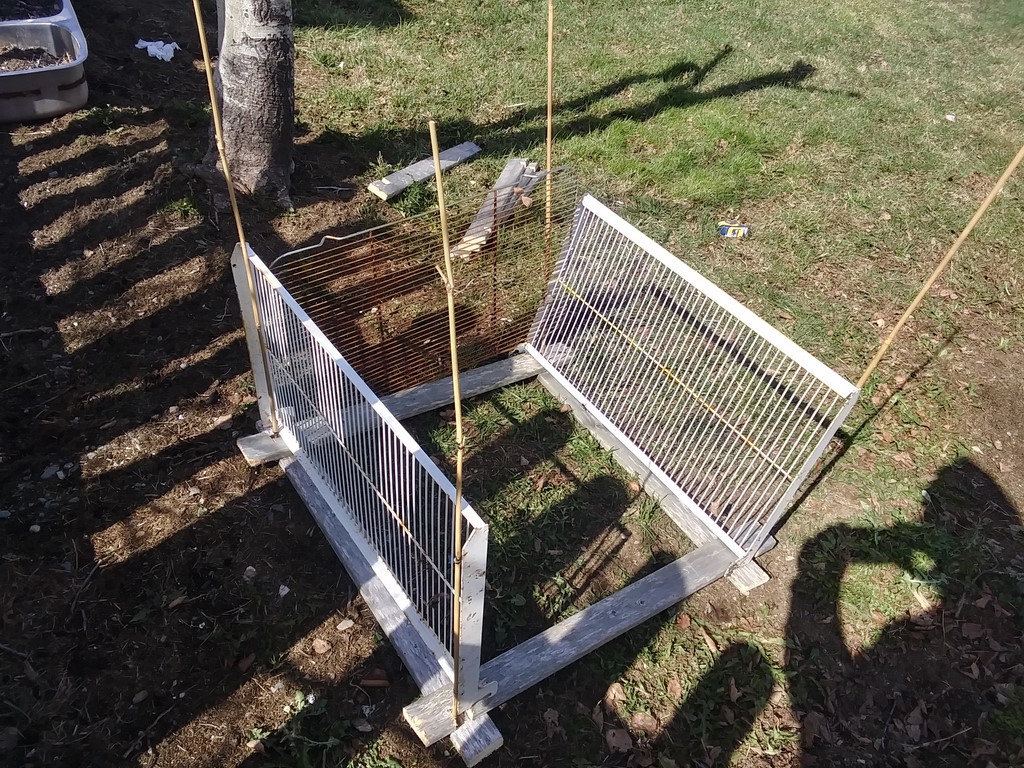
I could use refrigerator shelves (free at your local rubbish tip) as walls, but they are too large to stack alternately, and so cannot relay on the bamboo cane for support.
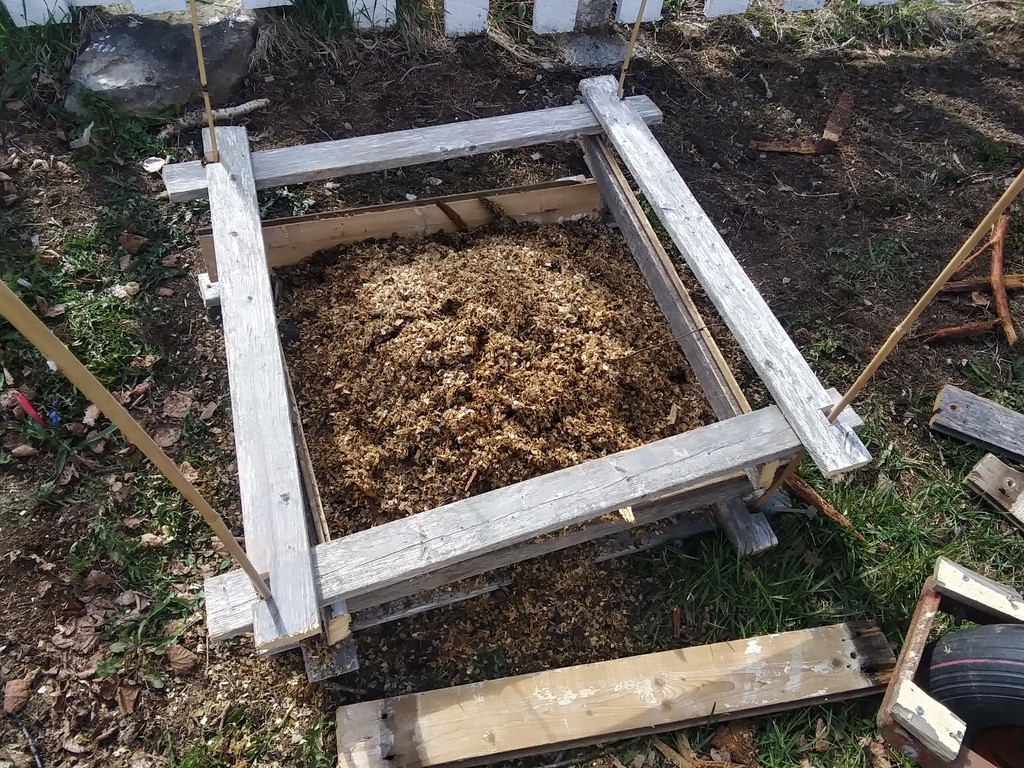
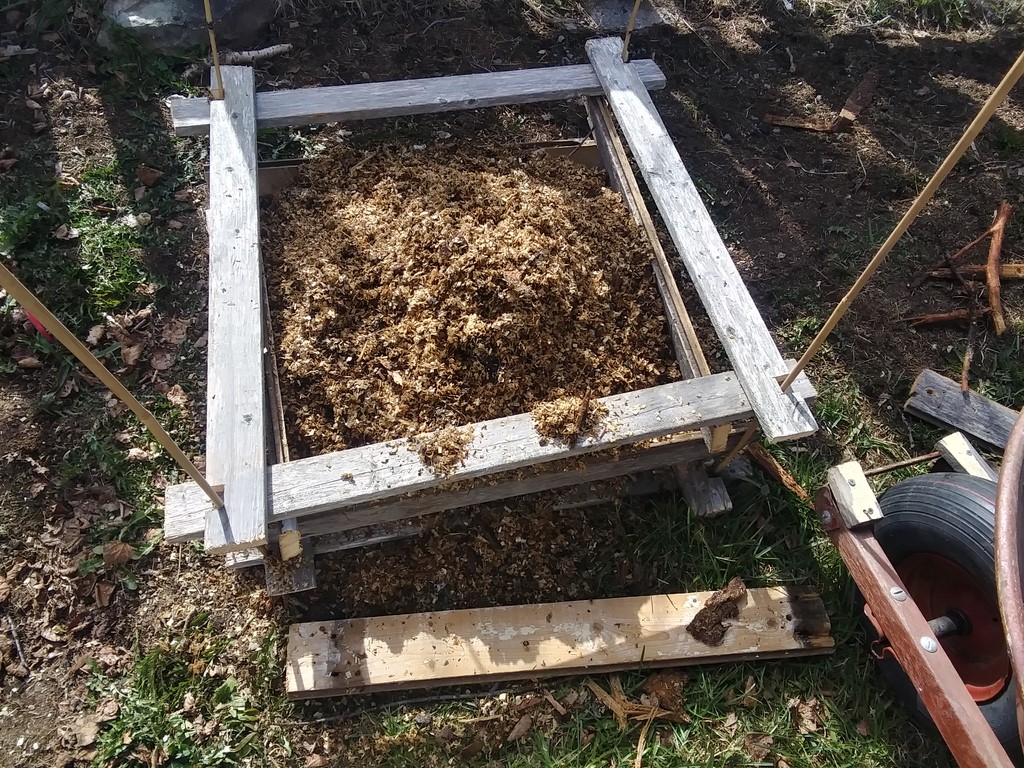
A series of regular palings, as seen on the ground, are stacked pair wise running N-S, and then E-W, then N-S and so on. This will leave a convenient air-gap the width of the palings.
You will not need identical palings; any scrap of wood, even tree limbs of roughly equal size, will work well.
I have loaded a barrow of sawdust (from sawing logs for fuel) as the first later, sitting directly atop the lawn.
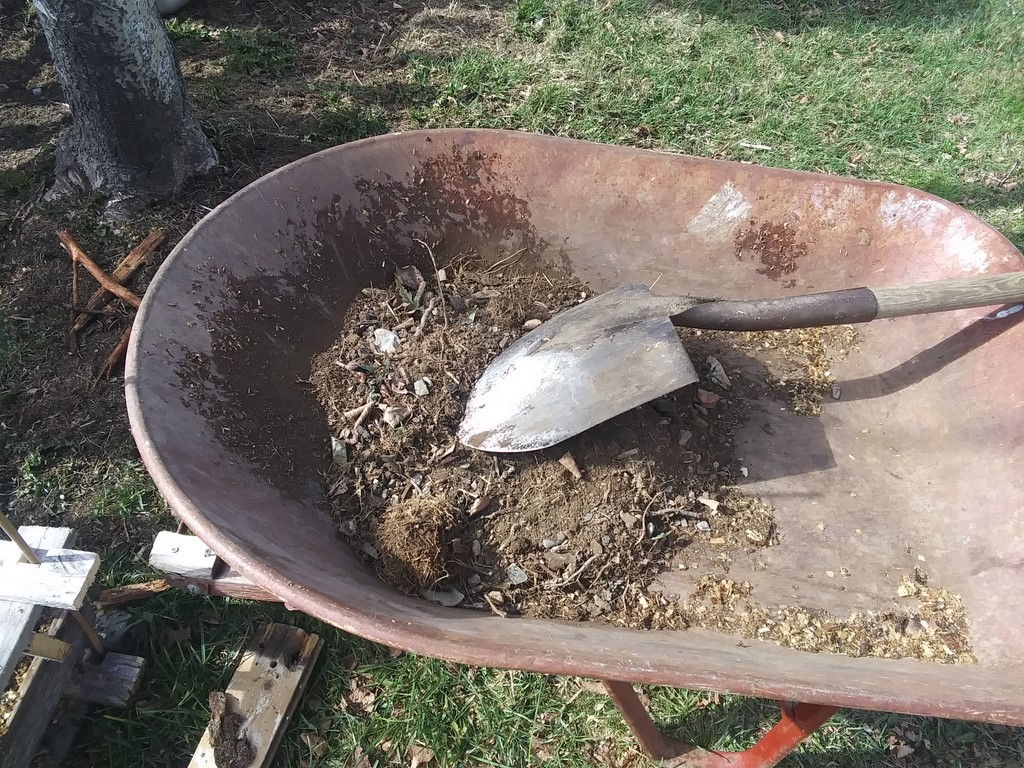
I bring just four shovels of old soil for the next layer.
Do not use the compost heap as a sink to put soil. The plan is to have the compost heap make soil, not absorb it.
We need the soil for the bacteria and microbe life, so that that life can start to work on the sawdust and grass clippings. I believe that the earthworms ingest small particles of soil for grinding in the gut.
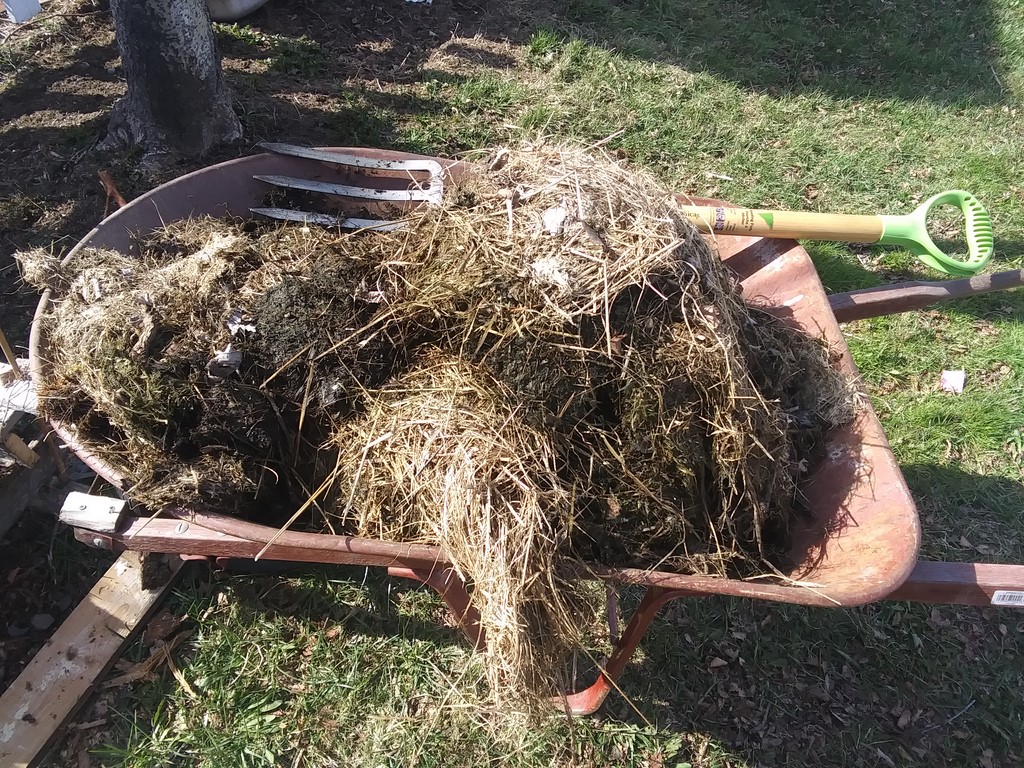
I had a pile of grass clippings that sat through winter. By now they have begun to rot and attract colonies of worms. I skim them plate-like from the heap.
\This barrow load is probably equivalent to two or three barrows of fresh grass-clippings.
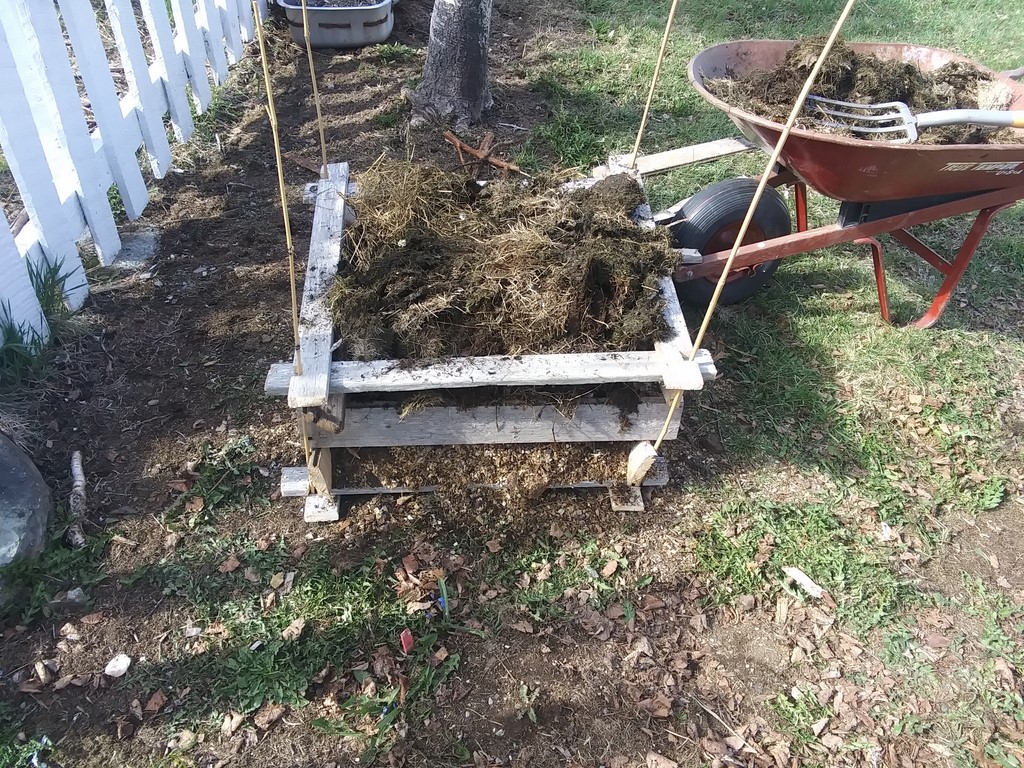
And onto the pile they go. Next four more shovels of soil, then sawdust, soil, grass and so on. The current material will settle down and compress top about half this height over the next few weeks.
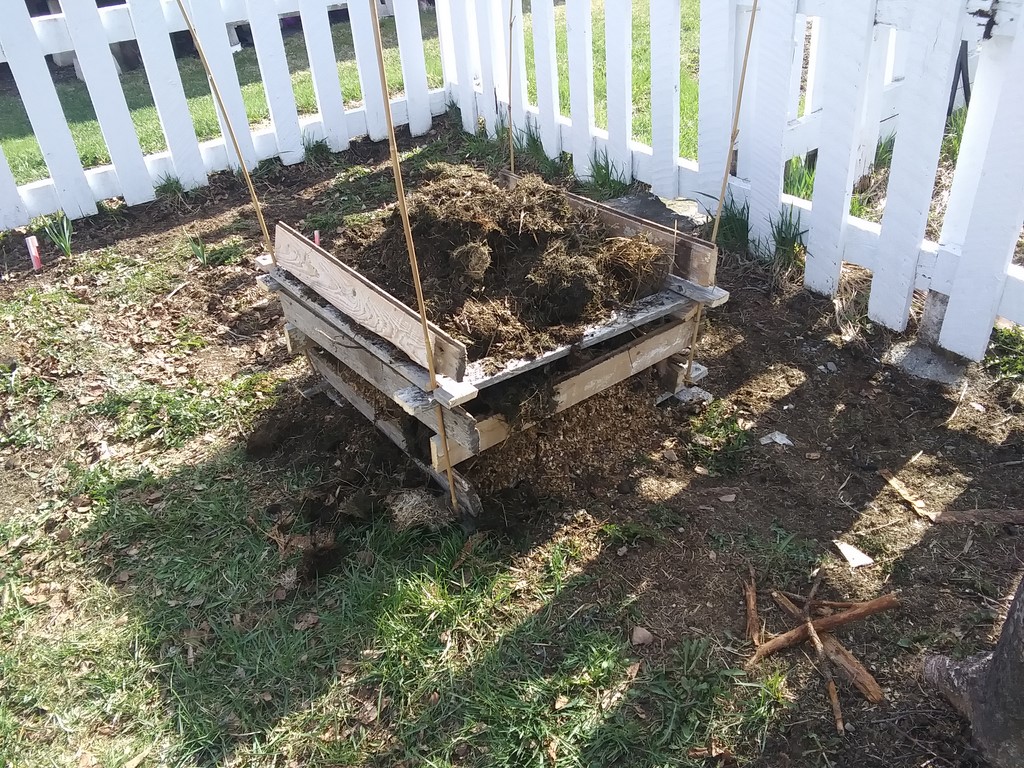
I have balanced the next pair of N-S palings atop the wall ready for the next load of material.
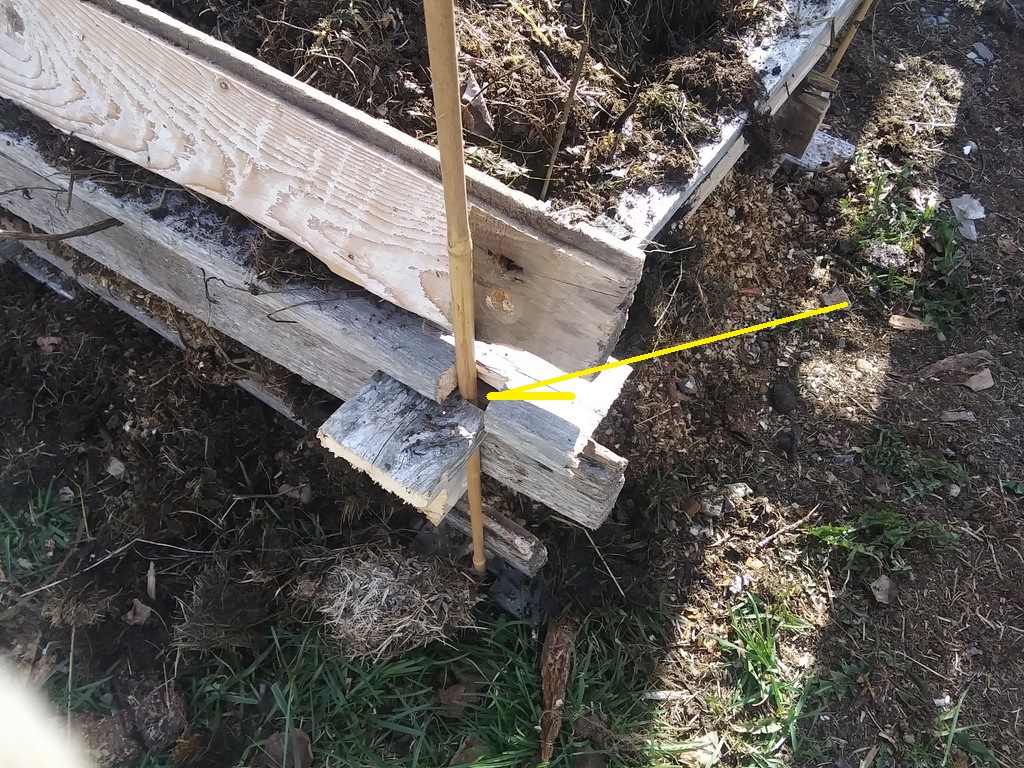
Immediately below my N-S notched paling is an E-W notched paling. The arrow points to that notch.
This layer of palings is temporary, and will be moved up a few inches at a time to a point about eighteen inches above the ground, then more regular palings, and finally a third set of notched palings at the top of the heap.
Sunday, August 21, 2022
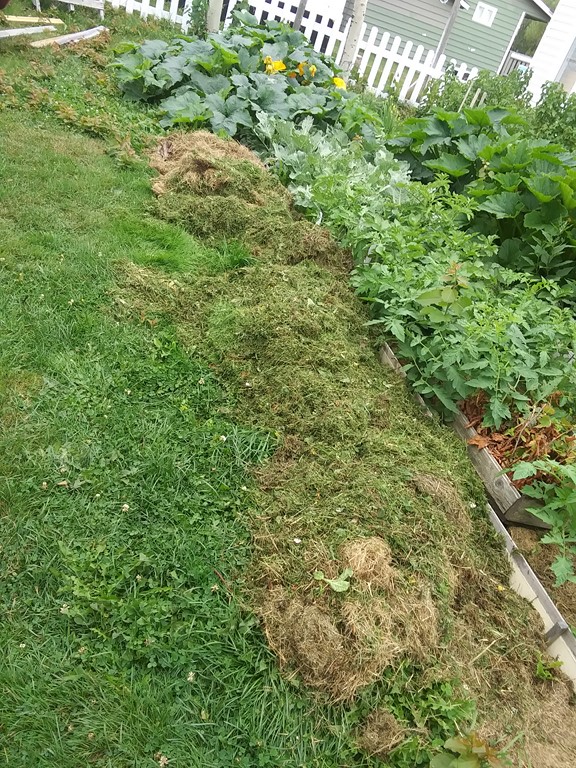
A dozen or more bags of grass clippings, two trucks of hay, and a side-by-side of grass clippings overwhelmed my bin capacity. The logistics of obtaining wood to make panels, to assemble bins, to match grass with old soil and sawdust is a problem at times.
Here I am in the process of widening a raised bed for next year. I dump a half-dozen barrows of clippings and ha alongside an existing bed.
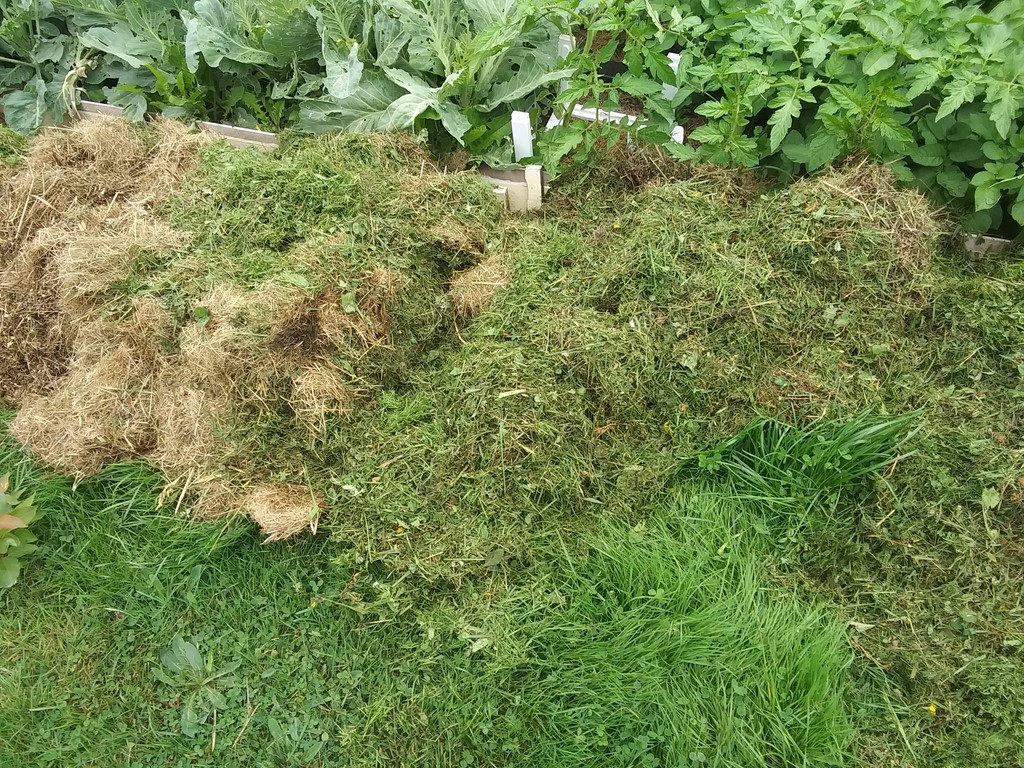
The material is dumped in heaps, although the heaps do not show up well as heaps in these images.
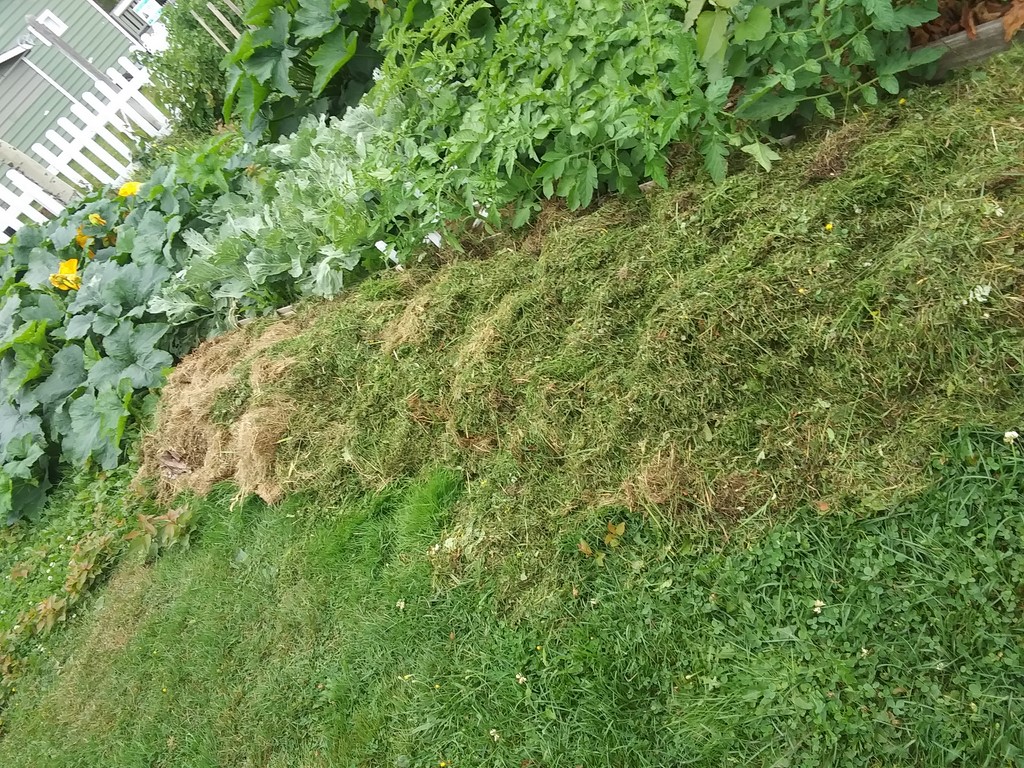
Then I rake the heaps, dragging the peaks into the hollows. I reckon that I need a full foot of clippings to mat down and kill off the grass so that the roots will die over winter, making the grass-covered area easier to dig over next spring.
That, or I can just place the new raised bed planks in place and drop compost on the matted material and plant seeds or seedlings.
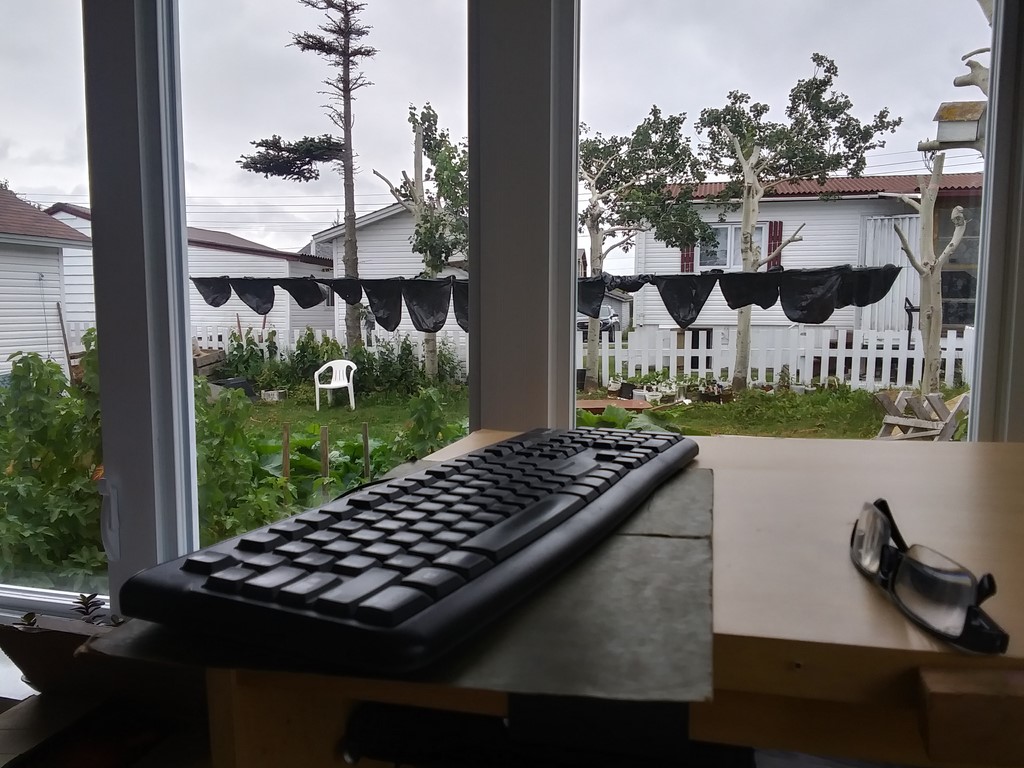
A row of grass clipping bags, turned inside out and hung out to dry. I spread the rumour that I don't want the guys to deal with rotting grass in the bags, so they air out for a day before being packed for re-use. But the truth is that I am a miserly old fart, and want the wind to shake out every clipping of grass that is available to me.